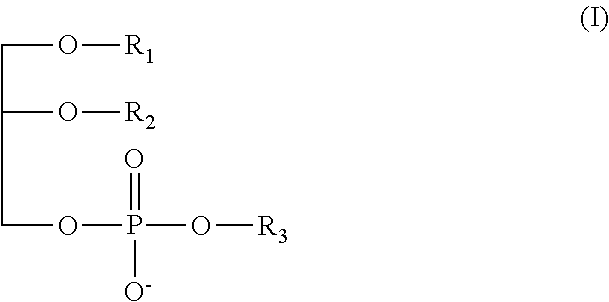Phospholipid compositions and their preparation
a technology of phospholipids and compositions, applied in the field of phospholipid compositions, to achieve the effect of reducing undesired components and high phospholipid conten
- Summary
- Abstract
- Description
- Claims
- Application Information
AI Technical Summary
Benefits of technology
Problems solved by technology
Method used
Image
Examples
example 1
[0194]This example describes the extraction of oil from a wet material. A coagulum from krill comprising about 70% water, 15% lipids and about 15% other dry matter, mainly proteins, was obtained as described in reference 16. This material was subjected to an extraction procedure as follows. 3500 grams of pure ethanol was added to 1004 grams of the coagulum and stirred for 45 minutes. The mixture was then filtered through a filter paper applying vacuum on the receiving flask to obtain 3854 gram of filtrate. 1179 gram of the filtrate was subjected to evaporation on a rotary evaporator and the obtained dry matter was washed 4 times with a 60% solution of ethanol and finally the solvent was evaporated in a rotary evaporator. The obtained oil, 23.7 gram, was solid at room temperature and comprised 76.8% phospholipids. Water is removed by freeze drying.
[0195]The content of EPA was 200 mg / gram and the content of DHA 87 mg / gram oil. The composition of the phospholipid fraction was as follow...
example 2
[0196]This example describes an alternative method for extraction of oil from the krill wet material, starting from a frozen paste from krill, which was subjected to an extraction procedure as described below. Unlike example 1, all steps were performed under a nitrogen atmosphere.
[0197]The paste comprises about 65% water (assessed via dry matter), 17% lipids (about equal weights of phospholipids and neutral lipids), and about 18% other dry matter, mainly proteins. Within the lipids, the proportions of certain fatty acids by weight were as follows: C16:0 about 15-17%; C14:0 about 6-10%; C18:3 n-3 about 1.4-3.1%; and C18:4 n-3 about 3.5-7%.
[0198]100 kg of the frozen coagulum (−20° C.) was added to a vessel. Based on the water content of the coagulum, 350 kg of pure ethanol (99.8% w / w, room temp) was then added to the vessel, giving a final ethanol concentration in the liquid phase of about 84% w / w (˜350 kg ethanol in 415 kg liquid solvents). Ethanol was added to give near to the desir...
example 3
[0212]Rather than being subjected to cold acetone precipitation, the washed lipid-rich material produced during example 2 (80% phospholipid, 20% neutral lipid) was precipitated using ethyl acetate. In initial testing, the material was thoroughly mixed with 3 parts of ethyl acetate at room temperature and then placed at 4° C., −11° C. or −20° C. No precipitation was seen at 4° C., but there was some phase separation at −11° C. and precipitation was observed at −20° C.
[0213]Further washed lipid-rich material was mixed with 2, 3 or 5 parts of ethyl acetate and placed at −20° C. to achieve precipitation. With 3 parts of solvent the phospholipid yield was 32%, but with 5 parts of solvent the yield was 66%. Re-precipitation of this material gave results as follows:
PhospholipidPrecipitationYieldPhospholipidNeutral lipidyield165.6%96.1%3.9%81.6%295.4% 99% 1%62.6%
[0214]Thus phospholipids can be effectively purified from the washed krill extract using repeated steps of precipitation with 5 vo...
PUM
| Property | Measurement | Unit |
|---|---|---|
| temperatures | aaaaa | aaaaa |
| temperature | aaaaa | aaaaa |
| temperature | aaaaa | aaaaa |
Abstract
Description
Claims
Application Information
 Login to View More
Login to View More - R&D
- Intellectual Property
- Life Sciences
- Materials
- Tech Scout
- Unparalleled Data Quality
- Higher Quality Content
- 60% Fewer Hallucinations
Browse by: Latest US Patents, China's latest patents, Technical Efficacy Thesaurus, Application Domain, Technology Topic, Popular Technical Reports.
© 2025 PatSnap. All rights reserved.Legal|Privacy policy|Modern Slavery Act Transparency Statement|Sitemap|About US| Contact US: help@patsnap.com


